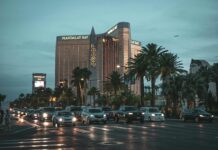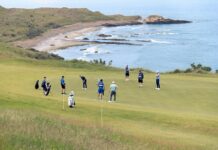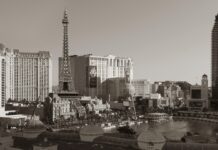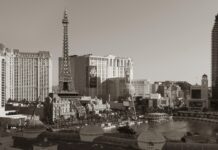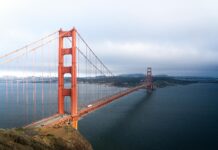The Las Vegas Mass Shooting stands as one of the most tragic and shocking events in recent American history, leaving millions in disbelief and sorrow. If you’re searching for shocking facts you need to know about the Las Vegas mass shooting, you’re in the right place. This article dives deep into the chilling details and lesser-known truths surrounding the deadliest mass shooting in modern U.S. history. But what really happened on that fateful night? And why does the Las Vegas shooting continue to haunt the nation’s collective memory?
On October 1, 2017, the world watched in horror as a gunman opened fire from the Mandalay Bay hotel, targeting a crowd attending the Route 91 Harvest music festival. The Las Vegas mass shooting details reveal a calculated and devastating attack that killed 60 people and injured hundreds more, making it the deadliest mass shooting carried out by an individual in the United States. But beyond the headline numbers, there are shocking facts about the Las Vegas shooting that most people don’t know — like the number of weapons used, the police response, and the aftermath for survivors and families.
Why did this tragedy happen? What were the motives behind the shooter’s actions? And how has the Las Vegas mass shooting changed gun laws, security measures, and public awareness about mass violence? Stay with us as we uncover the most compelling and eye-opening information about this horrific event. Whether you’re researching for awareness or seeking to understand the impact, these must-know facts about the Las Vegas mass shooting will leave you stunned and informed.
Unveiling 7 Shocking Facts About the Las Vegas Mass Shooting You Never Knew
The Las Vegas mass shooting shocked the world on October 1, 2017, when a gunman opened fire from the 32nd floor of the Mandalay Bay Resort, killing 60 people and injuring hundreds more. While many are familiar with the tragic event, there are still some surprising facts about this incident that you might never knew before. This article will unveil 7 shocking facts about the Las Vegas mass shooting that will make you see the event in a different perspective.
1. The Shooter’s Planning Was More Extensive Than Reported
Stephen Paddock, the gunman, didn’t just act impulsively or randomly. Investigators found that he planned the attack for months, maybe even years. The amount of weapons and ammunition he had collected over time was staggering. In fact, he had over 23 firearms in his hotel suite alone, along with hundreds of rounds of ammunition. The meticulous preparation showed a level of intent that was chilling, and some reports say he even practiced shooting from windows before the attack happened.
2. The Event Was the Deadliest Mass Shooting in Modern U.S. History
Before Las Vegas, the deadliest mass shooting in modern American history was the Pulse nightclub shooting in Orlando, Florida, 2016, where 49 people died. The Las Vegas shooting surpassed that with 60 fatalities, making it the deadliest mass shooting committed by a single person in the country. This tragic fact changed the conversation publicly about gun control, public safety, and event security.
3. The Shooter Managed to Bypass Hotel Security
One of the more unnerving facts is how Paddock was able to bypass hotel security measures. He checked in under a fake name and brought in suitcases full of weapons without raising suspicion. Mandalay Bay hotel security did not detect the arsenal during his stay, which lasted for several days before the shooting. This raised questions about hotel security protocols and how they’ve been improved since then.
4. The Official Motive Remains Unknown
Unlike many other mass shootings, Stephen Paddock left no clear motive for his actions. Despite extensive investigations by the FBI and local law enforcement, no manifesto or statement explaining why he committed such violence was found. His background revealed no significant political or religious motivations, which baffles many trying to understand why he did it. This missing piece continues to fuel conspiracy theories and speculation among the public.
5. The Emergency Response Was Both Criticized and Praised
The emergency response to the shooting was chaotic but also heroic in many ways. First responders arrived quickly, and many bystanders helped victims before paramedics could get there. However, some survivors criticized the speed and coordination of law enforcement during the incident. The event sparked a nationwide review on emergency preparedness at large venues, leading to new guidelines and training for mass casualty situations.
6. The Aftermath Changed Las Vegas Forever
The impact of the shooting on Las Vegas extends beyond the immediate tragedy. The city, known for its vibrant nightlife and tourism, had to rethink its approach to security at large events. Venues now have stricter bag checks, more armed security personnel, and advanced surveillance systems. Additionally, the community has come together in various ways to support survivors and families affected by the shooting, showing resilience despite the trauma.
7. The Long-Term Effects on Survivors and Families Are Still Unfolding
Many people don’t realize the long-term effects this shooting has had on survivors and the families of victims. Physical injuries are often visible, but psychological scars can be invisible and last for years. Post-Traumatic Stress Disorder (PTSD), anxiety, and depression have been reported among many who were at the concert. Support groups and counseling services have been crucial in helping these individuals cope, but recovery is ongoing, and there is no simple fix.
Here is a quick overview of these facts in a table format for clearer understanding:
| Fact Number | Shocking Fact | Brief Explanation |
|---|---|---|
| 1 | Extensive planning by the shooter | Paddock prepared for months with many weapons |
| 2 | Deadliest mass shooting in modern U.S. history | Surpassed previous records with 60 deaths |
| 3 | Shooter bypassed hotel security | Entered with fake ID, no detection of weapons |
| 4 | Motive remains unknown | No manifesto or clear explanation found |
| 5 | Emergency response had mixed reviews | Quick help but some criticized law enforcement |
| 6 | Las Vegas changed security measures | Stricter protocols and community support |
| 7 | Long-term psychological impact on survivors and families | PTSD and counseling needs continue |
To put things in perspective, if you compare the Las Vegas shooting to other mass shootings, what stands out is the scale and the shooter’s
How the Las Vegas Mass Shooting Changed Gun Control Debates Forever
The Las Vegas Mass Shooting Changed Gun Control Debates Forever
The tragic event that happened in Las Vegas on October 1, 2017, shook not only the city but the entire nation. Known as the deadliest mass shooting in modern U.S. history, it instantly became a pivotal point in gun control discussions. This horrific attack forced Americans to rethink how guns are regulated and sparked debates that are still ongoing today. The Las Vegas Mass Shooting, with its shocking facts and unprecedented scale, raised questions that nobody could ignore anymore.
Las Vegas Mass Shooting: Shocking Facts You Need To Know
On that fateful night, a gunman opened fire from the 32nd floor of the Mandalay Bay Resort and Casino during a music festival called Route 91 Harvest. The shooter used multiple firearms, including several semi-automatic rifles equipped with bump stocks—a device that allows a semi-automatic weapon to fire rapidly like an automatic rifle. This detail alone became a critical point in gun control debates.
Here are some shocking facts about the event:
- 60 people were killed, and over 400 injured, making it the deadliest mass shooting in U.S. history.
- The shooter fired more than 1,000 rounds in about 10 minutes.
- The use of bump stocks allowed the shooter to fire at a rate of roughly 800 rounds per minute.
- Over 22,000 people were attending the outdoor country music festival.
- The attacker was identified as Stephen Paddock, a 64-year-old man with no clear motive.
- Law enforcement found 23 firearms in his hotel suite.
The scale of this attack was shocking, but the way the shooter managed to execute it raised questions about how easily dangerous weapons can be modified and obtained.
How The Incident Changed Gun Control Debates
Before the shooting, bump stocks were relatively unknown to the general public and lawmakers. After the tragedy, they got into the spotlight. Many argued that these devices should be banned since they effectively turn semi-automatic rifles into fully automatic ones, which are heavily regulated by federal law.
The debate became more intense because it highlighted loopholes in the gun laws. For example:
- Bump stocks were legal to buy and use before the shooting.
- The attacker legally purchased all his weapons and accessories.
- There was no required background check for buying bump stocks.
- Multiple states had different regulations regarding firearm accessories.
In response to the shooting, the Trump administration eventually banned bump stocks in 2019. This was a rare instance where federal policy changed quickly after a mass shooting. However, the larger conversation about gun control—like assault weapon bans, background checks, and mental health screenings—continued to be highly divisive.
Historical Context: Gun Control Before Las Vegas
Gun control laws have been a controversial topic in the U.S. for decades. Some previous mass shootings, such as those at Columbine High School in 1999 and Sandy Hook Elementary in 2012, also intensified the gun control debate but didn’t lead to significant legislative changes at the federal level.
Before 2017, many gun laws focused on:
- Background checks for gun purchases.
- Restrictions on certain types of firearms, like assault weapons.
- Waiting periods before buying guns.
- Limits on magazine capacity.
But the Las Vegas shooting exposed how modifications like bump stocks can bypass many of these measures. It showed that even with existing laws, a determined individual could still inflict massive harm.
Comparison of Gun Control Reactions Before and After Las Vegas Mass Shooting
| Aspect | Before Las Vegas Shooting | After Las Vegas Shooting |
|---|---|---|
| Awareness of bump stocks | Low, mostly unknown to public | High, became central to debates |
| Legislation on bump stocks | No federal restrictions | Federal ban implemented in 2019 |
| Public opinion on firearms | Divided, many focused on assault weapons | More focus on accessory regulation |
| Political response | Limited federal action after shootings | Some swift policy changes post-event |
| Gun violence prevention | Mainly focused on background checks | Expanded to include accessory bans |
This table shows how the Las Vegas shooting served as a turning point in which some topics became more urgent and visible.
Practical Examples of Changes After the Shooting
Several states and cities adjusted their laws regarding firearms and accessories after the shooting. For example:
- Nevada banned bump stocks in 2018, before the federal ban.
- New York and California increased restrictions on gun accessories.
- Some lawmakers proposed stricter background checks and waiting periods.
- Gun manufacturers stopped producing bump stocks voluntarily after the ban.
Additionally, the shooting led to increased funding for research on gun violence, something that was limited for years due to political reasons.
Why The Debate Remains Complex
Even with these changes, gun control debates remain complicated for many reasons. The Second Amendment protections, cultural attitudes towards guns, and political
Inside the Timeline: What Really Happened During the Las Vegas Mass Shooting
The Las Vegas mass shooting remains one of the most devastating and tragic events in recent American history. It shocked not only the city but the entire nation. Understanding the timeline, the shocking facts, and what really happened that night is crucial to grasp the full impact of this horrific incident. Many people still have questions about how things unfolded, and this article will try to shed light on the details, even if some of the information might seem complex or hard to digest.
Inside the Timeline: What Really Happened During the Las Vegas Mass Shooting
The shooting took place on October 1, 2017, during the Route 91 Harvest music festival, an outdoor country music event held on the Las Vegas Strip. The attacker, Stephen Paddock, opened fire from the 32nd floor of the Mandalay Bay Hotel, targeting the crowd below. The chaos began shortly after 10:05 p.m. and lasted about 10 minutes, but those minutes felt like eternity for the thousands of people attending.
- 10:05 p.m. – Paddock starts shooting from his hotel room window using multiple firearms, some modified to fire faster.
- 10:10 p.m. – Festival-goers start realizing the sound of gunfire, initially confusing it with fireworks or other noises.
- 10:15 p.m. – Police receive multiple 911 calls reporting active shooter.
- 10:25 p.m. – Police arrive on the 32nd floor and begin breaching Paddock’s hotel room.
- 10:30 p.m. – Paddock is found dead from a self-inflicted gunshot wound.
Despite the short duration of the attack, the impact was catastrophic. Authorities confirmed 60 people were killed and over 850 injured, making it the deadliest mass shooting by a lone gunman in U.S. history.
Las Vegas Mass Shooting: Shocking Facts You Need To Know
There are several facts about the Las Vegas shooting that many people might not know about, which could help understand the complexity behind the event.
- The number of weapons: Paddock had 23 firearms in his hotel suite, including rifles equipped with bump stocks that enable semi-automatic weapons to fire more rapidly.
- Planning and preparation: Investigators found that Paddock had spent months planning the attack, purchasing weapons and ammunition online.
- No clear motive: Despite thorough investigations, the FBI never identified a definitive motive for why Paddock committed this act.
- Escape routes: The shooter used an overlooked stairwell to move between floors, avoiding detection by security.
- Response time: Police response was rapid, but the shooter’s elevated position gave him a deadly advantage over the crowd.
Here is a simple table summarizing some key statistics from the event:
| Aspect | Detail |
|---|---|
| Date | October 1, 2017 |
| Location | Mandalay Bay Hotel, Las Vegas |
| Number of fatalities | 60 |
| Injured | Over 850 |
| Shooter | Stephen Paddock |
| Firearms used | 23 (including bump-stock rifles) |
| Duration of shooting | Approximately 10 minutes |
| Law enforcement arrival | Within 20 minutes |
Comparing to Other Mass Shootings in U.S. History
When people look back at mass shootings, it’s often hard to compare them because each incident has its own tragic uniqueness. The Las Vegas shooting stands out for several reasons:
- Scale: It had the highest number of casualties caused by a single shooter.
- Location: Occurred at a large public event with tens of thousands of people.
- Weaponry: Use of bump stocks was a significant factor in increasing the shooting’s lethality.
- Law enforcement response: Police managed to breach the room quickly, preventing further loss of life.
For example, the Pulse nightclub shooting in Orlando (2016) had 49 fatalities, but it took place inside a confined indoor venue. In contrast, Las Vegas was outdoors, which complicated emergency response and evacuation efforts.
Practical Lessons and Changes After the Incident
The Las Vegas mass shooting led to many discussions about gun control, public safety measures, and emergency response protocols. Some changes that were considered or implemented include:
- Bump stock bans: Several states and the federal government moved to ban bump stocks after realizing their role in increasing shooting speed.
- Improved event security: Music festivals and large gatherings now often have enhanced security screening and better communication systems.
- Emergency preparedness: Training for first responders and event organizers was expanded to cover active shooter scenarios more effectively.
- Mental health awareness: Discussions about identifying warning signs in individuals who may pose a threat became more prominent.
The tragedy also sparked debates about gun laws in the United States. While some argue for stricter regulations,
5 Critical Lessons from the Las Vegas Mass Shooting Every American Should Understand
The Las Vegas Mass Shooting remains one of the most devastating and shocking events in recent American history. On October 1, 2017, a gunman opened fire from the 32nd floor of the Mandalay Bay Resort and Casino, targeting a crowd attending the Route 91 Harvest music festival. The attack resulted in 58 deaths and over 850 injuries, marking it the deadliest mass shooting by an individual in United States history. While many Americans know the tragic facts, there are deeper lessons from this event that every citizen should understand and reflect upon. This article explores 5 critical lessons from the Las Vegas mass shooting that resonate beyond the tragedy itself.
1. The Importance of Emergency Preparedness Cannot Be Overstated
One shocking fact you need to know: many survivors credited quick thinking and emergency preparedness for saving lives. Despite the chaos, some people had plans or instincts that helped them act fast. Emergency responders also arrived quickly, but the scale of the attack showed there was room for improvement.
Consider this outline of key preparedness actions that can make a difference:
- Know your exits: Always be aware of multiple ways out in large gatherings.
- Stay calm: Panicking can slow down your reaction time.
- Follow authority instructions: Emergency personnel have the best information during crisis.
- Carry basic first aid knowledge: You never know when you might need to help others.
- Have a communication plan: Let loved ones know your whereabouts and check in.
In many ways, the tragedy exposed how unprepared some venues and attendees were for such an unprecedented attack. Its lesson is clear: preparedness must be a personal and community priority.
2. Gun Safety and Regulation Debates Intensified by the Incident
The Las Vegas mass shooting shocked the nation and reignited debates on gun control laws. The shooter used multiple firearms, including bump stocks that allowed semi-automatic rifles to fire rapidly like automatic weapons. This detail sparked widespread outrage and calls for banning such devices.
Comparing gun laws across states reveals stark differences:
| State | Assault Weapons Ban | Bump Stock Ban | Gun Ownership Rate (per 100 residents) |
|---|---|---|---|
| Nevada | No | No (until 2019) | 23.1 |
| California | Yes | Yes | 20.6 |
| Texas | No | No | 35.1 |
The Las Vegas shooting showed loopholes in gun control laws can have fatal consequences. It reminded Americans that legislation often trails behind technology and tactics used by attackers, needing constant updates.
3. Mental Health Issues Are Complex and Cannot Be Overlooked
Although the shooter’s motive remains unclear, reports indicated signs of mental health struggles. This aspect highlighted the challenges in identifying and intervening in potential threats without violating privacy or rights.
Key points to consider include:
- Mental health services lack funding and accessibility in many parts of the U.S.
- Stigma around mental illness prevents many from seeking help.
- Early intervention programs can help but require community involvement.
- Law enforcement often face difficulties distinguishing between threats and illness.
Everyone agrees mental health is a critical factor, but the Las Vegas shooting made all Americans realize how fragile the current systems are to prevent such tragedies.
4. Media Coverage Shapes Public Perception and Policy Responses
The way the Las Vegas mass shooting was reported influenced how people understood the event and demanded changes. The 24/7 news cycle, social media, and live footage brought the horror into homes instantly. However, sensationalism sometimes overshadowed deeper discussions.
Media impact includes:
- Rapid spread of misinformation and rumors.
- Focus on shooter’s identity, sometimes glorifying them unintentionally.
- Emotional stories from victims that promote empathy.
- Pressure on politicians to react quickly, sometimes leading to hasty policy.
In this chaotic media environment, Americans learned to seek reliable sources and question narratives rather than accepting everything at face value.
5. Community Resilience and Unity Emerge Stronger After Tragedies
Despite the horror, one uplifting lesson from the Las Vegas shooting was the incredible resilience of the community. People from all walks of life came together to support victims and rebuild.
Examples of this unity:
- Volunteers providing aid and shelter.
- Fundraisers raising millions for survivors and families.
- Las Vegas locals donating blood in record numbers.
- Vigils and memorials honoring those lost.
This tragedy reminded the nation that even in darkness, compassion and strength can shine through. Communities can heal when they stand together.
The Las Vegas mass shooting left a scar on America, but it also offered vital insights every citizen should understand. From emergency readiness and gun control debates to mental health awareness, media literacy, and community strength, these lessons remain relevant today. Everyone must remember the victims and work towards preventing future tragedies by learning from the past. The road ahead is difficult, but understanding these
Survivor Stories and Untold Details of the Las Vegas Mass Shooting Tragedy
The Las Vegas mass shooting is one of the deadliest tragedies in modern American history. It shocked the nation and left countless lives forever changed. While many headlines focus on the numbers and the event itself, there are survivor stories and untold details that reveal the human side of this horrific incident. People who were there, who lived through the chaos, shared memories that are sometimes painful but necessary to remember. These stories gives deeper insight beyond the basic facts.
What Happened During the Las Vegas Mass Shooting?
On the night of October 1, 2017, a gunman opened fire from the 32nd floor of the Mandalay Bay Resort and Casino at a crowd attending the Route 91 Harvest music festival. The shooting lasted for about 10 minutes, but in that short time, 60 people were killed and more than 800 were injured. It was the deadliest mass shooting by an individual in U.S. history. The shooter, Stephen Paddock, was found dead in his hotel room, having taken his own life before police could reach him.
Shocking Facts You Need To Know About The Incident
Many facts about the shooting might surprise you or were overlooked by mainstream media:
- The shooter had over 20 firearms with him, including multiple rifles modified with bump stocks to increase the rate of fire.
- The attack was completely unprovoked and without any clear motive that investigators could definitively determine.
- Emergency responders faced difficulties reaching victims due to the large crowd, and many survivors had to resort to their own methods to escape.
- The venue was outdoors, and the open space made it hard to find cover, increasing the vulnerability of the audience.
- Several people used their own medical training to assist the wounded before paramedics arrived.
Survivor Stories That Reveal Untold Details
Many survivors recount moments that are difficult to hear but important to understanding what happened. One woman described how she and her friends ducked behind a sound booth, covering their heads and hoping the shooter would stop soon. Another survivor, a man who was near the stage, said he saw people falling around him but kept moving forward to help a friend who got shot. These moments of bravery and fear coexist in everyone’s memories.
Some survivors also talk about the emotional aftermath, the trauma that lasts long after the physical wounds healed. PTSD, anxiety, and survivor’s guilt are common among those who were there. Many found support groups in Las Vegas, where sharing their stories helped them heal together.
Historical Context: Mass Shootings in America
The Las Vegas shooting fits into a troubling pattern of mass shootings in the United States, which have increased in frequency over the years. Comparing this event with others, like the Pulse nightclub shooting in 2016 or Sandy Hook Elementary in 2012, shows a grim progression in both the scale and methods used.
- Sandy Hook (2012): 26 dead, shooter used semi-automatic rifles.
- Pulse Nightclub (2016): 49 dead, shooter used AR-15 style rifle.
- Las Vegas (2017): 60 dead, shooter used multiple rifles with bump stocks.
This comparison shows how weapons technology and shooter tactics evolving, often making these tragedies more deadly.
Practical Examples: How Survivors Managed To Escape
Many survivors used split-second decisions to save their lives. Here are some common tactics they reported:
- Running towards the venue’s exits instead of away from the noise.
- Using barriers like tents, vehicles, or fences as shields.
- Helping others who were injured, even in the midst of danger.
- Staying low to the ground to avoid bullets.
- Calling emergency services as soon as it was safe.
These examples show the importance of quick thinking during an unexpected crisis, and they might help people prepare mentally for emergencies.
Emotional Impact On The City Of Las Vegas
Las Vegas itself was deeply affected by the shooting, not just because it happened there, but because the city is known as a place of entertainment and joy. The mass shooting shattered that image for many locals and visitors. Memorials were set up, and annual events now remember the victims and honor the heroes who responded.
The economic impact was also significant, with some events canceling or reducing attendance for months afterward. However, the resilience of the community showed through as people came together to support each other and rebuild a sense of safety.
Table: Key Details of the Las Vegas Mass Shooting
| Detail | Information |
|---|---|
| Date | October 1, 2017 |
| Location | Mandalay Bay Resort & Route 91 Festival |
| Shooter | Stephen Paddock |
| Number of fatalities | 60 |
| Number of injured | Over 800 |
| Duration of shooting | Approximately 10 minutes |
| Weapons used | Multiple rifles with bump stocks |
| Shooter’s fate | Suicide in hotel room |
This
Conclusion
The Las Vegas mass shooting stands as one of the most tragic and devastating events in recent American history, highlighting critical issues surrounding gun control, public safety, and emergency response preparedness. Throughout the article, we examined the details of the incident, the motives behind the attack, and the profound impact it had on victims, families, and the broader community. It also underscored the urgent need for comprehensive policy reforms aimed at preventing similar tragedies in the future. As we reflect on this somber event, it is imperative for individuals, lawmakers, and advocacy groups to come together in support of meaningful change that prioritizes human lives and enhances security measures. Remembering the victims and honoring their memory means committing to actions that foster safer environments for all. Only through awareness, education, and proactive legislation can we hope to reduce the likelihood of such heartbreaking events reoccurring.
